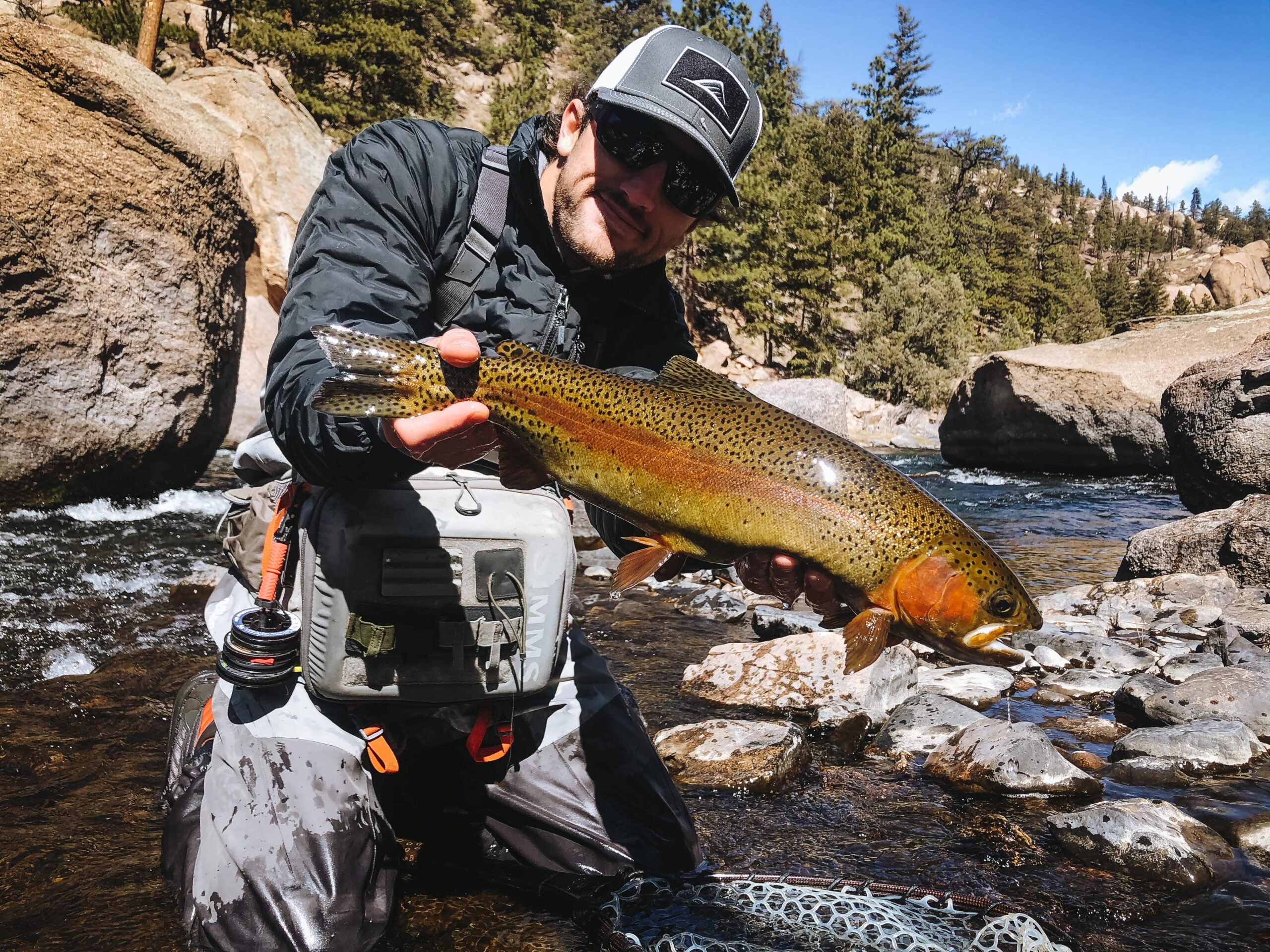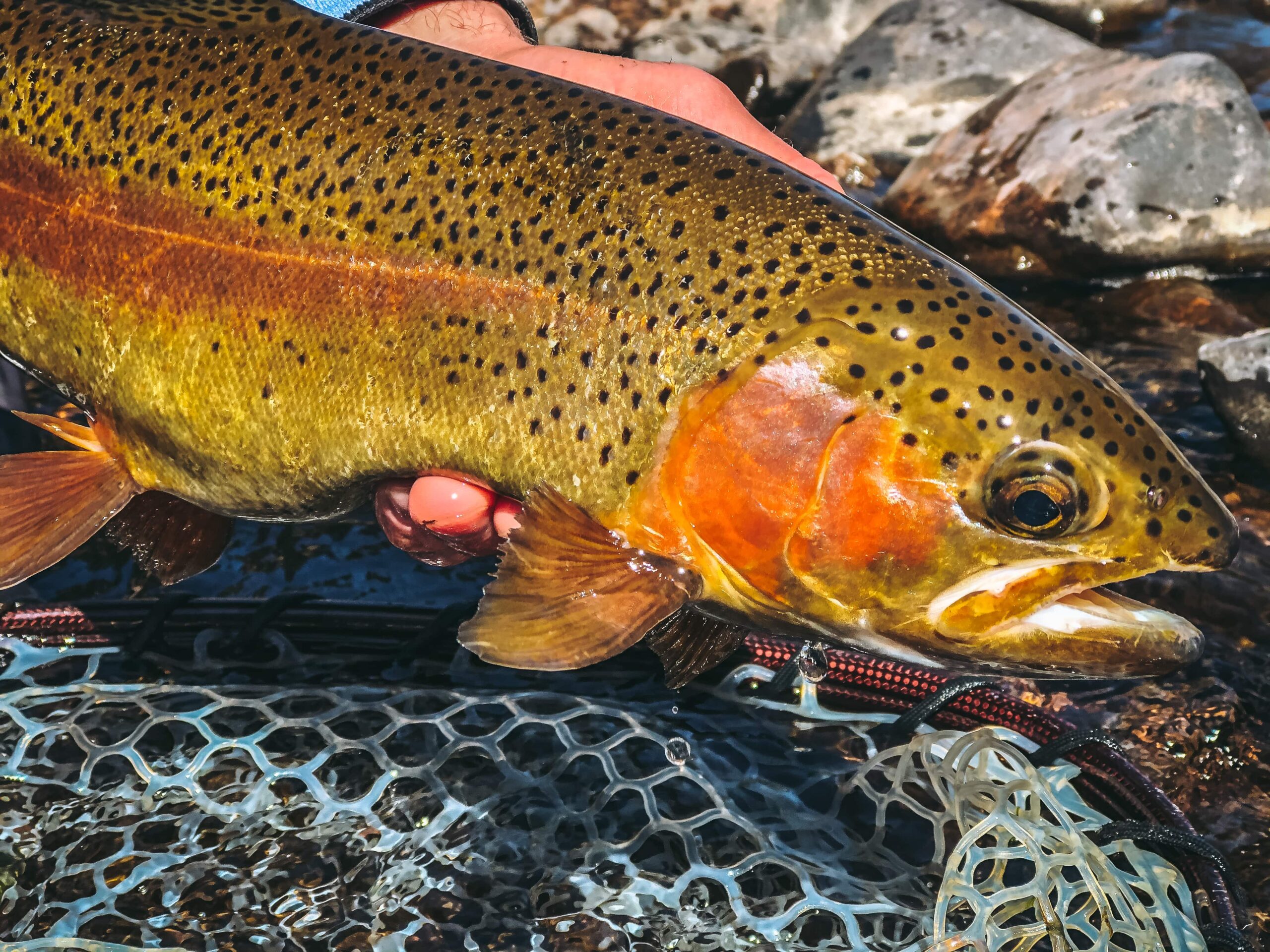Fly Fishing The South Platte River in Cheesman Canyon
They say if you can catch trout in Cheesman Canyon, you can catch trout anywhere.
Current Cheesman Canyon Fishing Conditions
Latest Update
03/25/21
Conditions
Fishing is heating up. Bluewings are starting to pop and fish were pushing into traditional feeding lies. As the water temps start to warm expect the fishing to get better. With flows still pegged around 40 cfs expect technical conditions and light tippets.
Effective Patterns
We had some really good takes on baetis nymphs, especially in some shallow riffles. Also caught a bunch of fish on usual suspects like black beauties and pale olive larvas.
Seasonal Fishing Strategies
Winter
Cheesman yields great winter fishing. Midge hatches will provide trout with their primary food source during this time of the year. It is important to carry a variety of midge patterns from larva all the way to dries. With lower flows and lethargic trout, winter fishing often calls for extra fine tippet and small bugs. Normally between 5X-7X and size #20-26 flies. During the winter I tend to focus on slower deeper poles that act as great winter holding areas for large congregations of Cheesman trout.
Spring
Spring fishing in Cheesman is some of my favorite, especially during good snowpack and runoff years. During spring time high flow periods Cheesman fish gorge themselves on larger bugs and protein sources. My favorites are scuds and craneflies. This is also a great time to “rope-up” in the canyon and fish some larger 4X tippet. During high flows, focus on seams created by boulders, areas of color & substrate change, and tailouts.
Summer
During high runoff years where flows high flows last into the summer months I will fish bigger nymphs like stoneflies and scuds. During stonefly hatches I will also fish larger dries that emulate a stonefly well like an Amy’s Ant. During low flow summers it is the typical tiny Cheesman flies that will produce. During the summer months I try to target actively feeding fish that I can spot in shallow water. I will also focus on prominent seems that give fish access to mutliple water types.
Fall
Fall is a great time to try some unorthodox methods in Cheesman. Aside from the typical tailwater bugs its a great time to try your luck with some smaller streamers. Some of my favorites are Slump Busters, Meat Whistles, and Baby Gongas.


Cheesman Canyon Overview
The saying that floats around the Colorado angling community is that “if you can catch trout in Cheesman, you can catch trout anywhere.” While I do absolutely agree that Cheesman trout are never easily fooled, I think that with the proper setup, a solid game plan, and decent execution, wonderful days in the canyon can certainly be achieved. With boulders ranging in size from a minivan to the size of your home, abundant wildlife, and gorgeous canyon walls in every direction, fish or no fish, you’re going to have a great experience.
Cheesman is filled with an abundant population of healthy, well-sized rainbow and brown trout and there are some better fish to be had if you are okay with putting in the extra effort to find them. Site fishing this stretch of river is the norm and more often than not you have to pinch yourself to remember you are not casting your flies into a fish tank, yes, there are that many fish. Fishing this pristine tailwater does require a short moderate-intensity hike that most people in fair condition can tackle without a problem.
Cheesman Canyon is an iconic tailwater section of the river on the South Platte River near Deckers, Colorado. Cheesman Canyon is one of my favorite places in Colorado for thousands of anglers for a multitude of reasons. The combination of proximity to Denver, a robust population of healthy rainbow and brown trout, and nearly unbeatable scenery make it a bucket list destination for most trout anglers in the United States.
The renowned tailwater section is formed by the 221 foot tall Cheesman dam that when constructed in 1905, was the largest of its kind in the world. The dam, named after water engineering pioneer, Walter Cheesman, was purchased in 1918 by Denver water for the main purpose of water supply and is now a National Historic Civil Engineering Landmark.
Lower Cheesman Canyon
Parking in the Gill trail parking lot and fishing the lower reaches of Cheesman Canyon is by far the easiest and fastest way to access the river. To hike the lower section expect roughly a mile or so of well-marked, moderate grade trail before you break out of the pines above the river.
However, while this requires much less effort than hiking the upper Cheesman canyon please be aware that this means exponentially more angling pressure. If you are looking for solitude and a river to yourself, Cheesman is definitely not the place for you, especially the lower section. On any given day from March to November with fair to moderate weather expect other anglers to be prevalent and to have to practice proper fly fishing etiquette.
Upper Cheesman Canyon
If you’re looking for a bit less of a crowd and some larger fish, then in my opinion Upper Cheesman canyon is the way to go. In my experience, there are larger fish to be had and they are certainly more willing to take a fly due to less angling pressure. However, opportunities like this come at a cost, the hike into this section is much more strenuous and is roughly 2.5 miles to get to the river. When hiking the upper trail I am always sure to take a backpack with a water bladder and filled with snacks to stay well-nourished. Especially after finishing a long day on the water, the last thing you want it to have to tackle the steep hike out with no energy, it can get miserable quick, trust me as I have made this mistake.
River Access & Directions
If Coming From Denver
If coming from Denver the best way to get to Cheesman is by driving highway 285 into Pine Junction. Once you enter Pine Junction, take a left at the stoplight onto 126 and follow it for about 25 miles until you come to a section where the road opens up to 3 lanes on a large downhill. At the bottom of this downhill, you will see a large parking lot on your left where you can park and hike to fish the lower section.
If Coming From Colorado Springs
If coming from Colorado Springs, follow HW24 into Woodland Park and take a right onto 67. Follow 67 for roughly 25 miles into Deckers and continue straight across the bridge. Drive another 2 miles and the parking lot will be on your left.